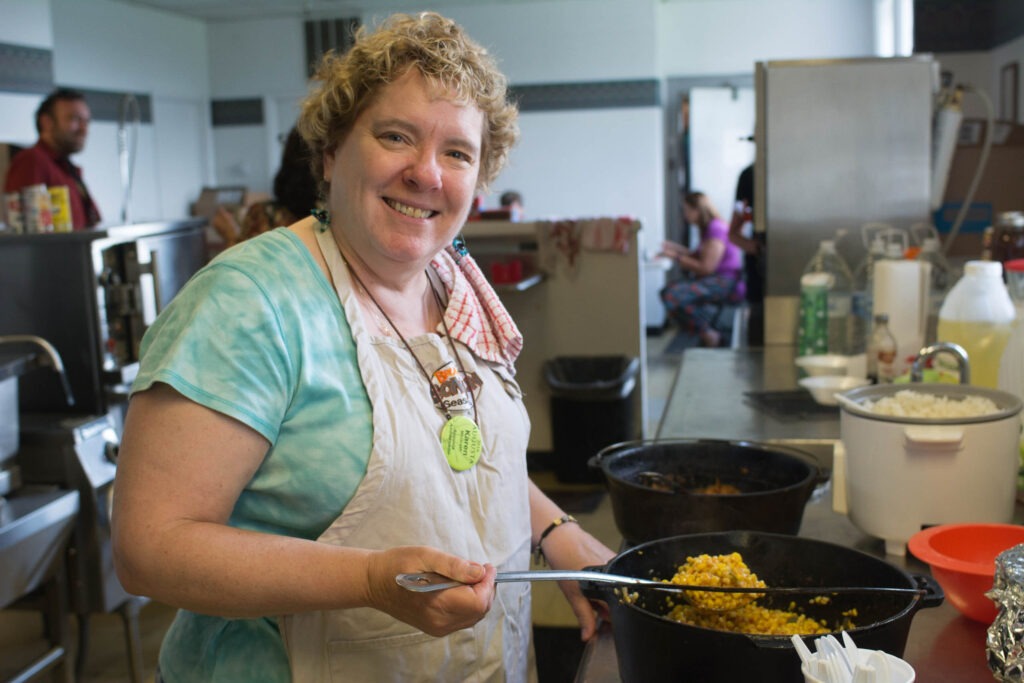The sound of Cajun music ringing into the cool night unmistakable.
But for the past two summers, the evening air at Augusta has been silent. Now, after two years of online programming, that unmistakable sound has returned and folks are excited.
Long time Augusta student, Karen McGrath, couldn’t be happier.

“It’s amazing. The contact is. I’ve been dancing in my kitchen for three years by myself or dancing online at festivals.”
And while folks built creative ways to continue to social dance online during the pandemic, there is no substitute for the sense of connection fostered while dancing in person.
“It’s the connection. It’s the actual physical connection. You’re breathing together. Which in COVID times is weird, hence the mask, but you are also making connections with the band. It’s a very synergistic relationship because the band is feeding off the dancers and vice-versa. There’s a real connection between what’s happening up on the bandstand and what’s happening on the floor. They just feed off one another.”
Sacred Spaces
Members of the Elkins community have a deep connection not only to the music and dance, but to the space. Tucked into a hillside below a grove of maple trees last tapped in the late 1980s, the Augusta Dance Pavilion was built in 1990. Prior to the construction of the open air dance pavilion, dances were held in ‘the pit’, now called the Myles Center Creative Commons, below Harper McNeely Auditorium.
For Kim MacAurther, who grew up dancing at the Augusta Dance Pavilion there’s no better place to be.
“Someone once asked me: what’s my vision of heaven? For me it’s Cajun/Zydeco Week at Augusta in July in an outdoor pavilion with a bunch of twinkly lights. I cannot imagine a better heaven than that. So, I’m a religious person and that’s still my definition of heaven. So after years of not being able to be here, it kinda feels like heaven. It’s just dreamy.”
Now MacArthur gets to share her heaven with her daughter.
“I was walking up here yesterday with my daughter and she said ‘Mamma, do we get to go honky tonk?’ and she strapped on her little cowboy boots and she’s ready to roll and it was literally like a moment that you dream of.”
The Value of Social Dance
But social dancing is not just about music or dance. MacArthur notes how it adds value to a community.
“One of the significant ones is that it brings all kinds of different people together. Right? There are people on this dance floor of all different ages, from all different places, with lots of different interests, and we all just shoot a grin at each other as we swirl by because we’re all enjoying the same sort of things even though we’re coming at it from all different places.”
McGrath echoes the sentiment.
“Anytime you’re face to face with a person without a screen in the way is a good thing. You’re making more of a connection. A deeper connection. At a dance, at a place especially like Augusta, you’re dancing with people from all over the country. You’re dancing with people of all ages. I’m dancing with people now that I remember dancing with their mothers when they were pregnant. You know? I mean that’s…I’ve got a long history here. And it’s that kind of a connection that I appreciate. I really look forward to seeing how big the kids have gotten.”
Beyond that, it’s the perfect environment to embrace the joy of learning something new.
“And so I think the joy of coming together and the joy of..for our kids at least it’s the joy of learning something new [interruption of fireflies]. I think the joy of learning something new. For some people they’ve never tried this before so it’s a little bit scary. Mana’kai had never tried this kind of dance before so my nephew having the opportunity to try something new is an important life skill. You know? You want to spend the rest of your life trying new things and encouraging yourself to step out. There are all kinds of good things happening up there.”


Please add me to your events mailing list. Thank you!
As a new student at Davis & Elkins College, I have repeatedly mindlessly walked by the Augusta dance pavilion and have thought nothing of it, dismissing it as just a pavilion. This article has shown me the significance and community values intertwined with the pavilion that I had previously not had a second thought about. I find the celebration of dance and Appalachian culture as an incredibly positive light for the community and hope to see the gathering grow!
The Augusta pavilion has changed many a life for the better over the course of several decades with world class music and dancers of all levels.
I spent 14 wonderful years at Swing Week dancing in that pavilion. The music, the artists, the dear friendly connections continue to nourish me.